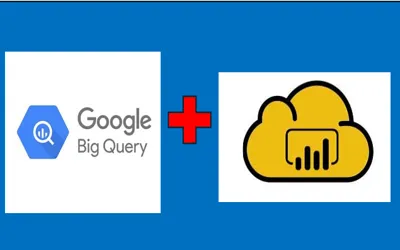Power BI and Google BigQuery Integration: Architecture, Pitfalls, and Business Value
Introduction
Organisations generate more data than ever before, and getting the best value requires the right combination of platforms and tools. Google BigQuery offers near-limitless scalability for storing and querying data, while Microsoft Power BI provides intuitive visualisation and reporting capabilities.
Undertaking a BigQuery Power BI integration enables organisations to combine Google’s scalable data warehouse with Microsoft’s analytics. This best‑of‑both‑worlds approach enables BigQuery’s performance to power enterprise‑scale reporting, with Power BI making insights available to decision‑makers. Yet this integration is as easy as it could be. From identity conflicts and authentication hurdles to query folding limitations and refresh constraints, organisations need to use the optimal architecture.
This article explores the business reasons for choosing Power BI with BigQuery, the technical challenges to be aware of, and the best practices to ensure success in building a modern, scalable data architecture.

Why undertake a Bigquery Power bi integration?
Commercial Benefits
- Ability to handle large datasets: By combining Power BI with BigQuery’s elastic compute power, organisations can analyse and visualise massive datasets that would overwhelm traditional BI tools. This enables reporting without compromising on performance.
- Cost flexibility: Power BI’s tiered licensing model (Pro, Premium, Embedded) allows organisations to scale their analytics investment according to their needs. In many cases, this pricing flexibility makes it a more cost-effective option than Tableau or Looker, especially at scale.
- Cross-platform accessibility: Even in Google-first environments, many businesses still use Microsoft productivity tools. Power BI offers a familiar and flexible reporting layer that connects Google Cloud back-ends with Microsoft’s front-end ecosystem.
- Ease of adoption: As many business users are already familiar with Power BI’s interface, reminiscent of Excel, training requirements are lower and adoption is faster compared to adopting entirely new platforms like Looker.
- Strong governance and compliance: Power BI provides robust workspace management, versioning, and enterprise-grade security, which are particularly valuable for organisations operating in regulated industries that require structured governance.
When Alternatives May Be Considered
- Google Looker Studio: Suited to organisations fully invested in the Google ecosystem.
- Tableau: Offers advanced visualisation flexibility but at a higher cost of ownership.
- Qlik: Provides strong associative modelling but is less common in Microsoft-heavy environments.
Technical Pitfalls of Integration
Authentication Challenges
One of the first hurdles is identity management. BigQuery requires a Google identity, but many organisations operate under Microsoft-only domains (e.g. user@company.onmicrosoft.com). Without a corresponding Google user, connection setup can stall. Consider the following patterns:
- Federate identities (recommended): Use Google Cloud Identity / Google Workspace SSO to federate Azure AD users to Google. This maps corporate users to Google identities without creating shadow accounts.
- Dedicated Google service user via OAuth (native connector): Create a minimal, locked-down Google Workspace user for data access and authenticate the Power BI BigQuery native connector with OAuth. Store the credential in a Power BI Data Gateway to avoid interactive sign-in on desktops.
- Service account via ODBC (when required): The native BigQuery connector does not support Google service-account key files directly. If you must use a service account, use the BigQuery ODBC driver (e.g., Simba) configured with the service account JSON. Connect Power BI via ODBC, and register the same DSN on the on‑premises data gateway for scheduled refresh. Trade‑off: limited query folding and potential feature gaps vs the native connector.
- Gateway host: The Power BI on‑premises data gateway requires Windows. In cloud setups, run it on a hardened Windows Server VM (Azure or Google Compute Engine). Use least‑privilege local accounts, restrict outbound egress, and enable MFA on the admin tenant.
- Security posture: Keep the OAuth token or service‑account key only on the gateway VM, use VNET/Firewall rules to restrict BigQuery access, and assign principle of least privilege roles (e.g., BigQuery Data Viewer on specific datasets).

Query Folding Limitations
As part of Bigquery Power BI integration, Power BI relies on query folding to push transformations back into the source system. With BigQuery, folding support is limited:
- Simple filters and projections may fold back efficiently.
- Complex transformations (joins, calculations) are often executed locally in Power BI.
- The risk: large datasets are pulled into Power BI, driving up costs and slowing performance.
Data Refresh Constraints
How to connect power bi to google big query is a key consideration, this is influenced on the refresh mode selected.
- DirectQuery Mode
- Up-to-date data: DirectQuery keeps Power BI reports current by issuing live queries to BigQuery rather than storing imported data.
- Performance issues: Query response times depend on BigQuery performance and network latency; complex joins or aggregations can slow dashboards significantly.
- Row limits: Power BI imposes limits in DirectQuery mode — by default, only 1 million rows per query can be returned to a visual. This means even if BigQuery can process billions of rows, Power BI will cap what’s displayed unless aggregations are pushed down.
- Cost considerations: Each interaction in a dashboard can trigger new BigQuery queries, which may drive up costs if not optimised.
- Import Mode:
- Offers faster performance but requires scheduled refreshes and may struggle with very large datasets.
Best Architecture for Power BI and BigQuery Integration
What is the best way to connect to google bigquery.
Option 1: Native Connector (Cloud-to-Cloud)
- Simplest setup using Power BI’s built-in BigQuery connector.
- Best suited for smaller datasets and straightforward reporting.
- Lower infrastructure overhead, but limited flexibility when transformations are complex.
Option 2: On-Premises Data Gateway (VM-Based)
- Power BI requires a gateway for scheduled refreshes in certain environments.
- A VM-hosted gateway allows use of service accounts for secure authentication.
- Must be deployed on a Windows VM, adding operational overhead in maintaining uptime and patching.
- Useful for organisations with strict security or compliance requirements.
Option 3: Hybrid Approach with Azure Integration
- Data can be staged in Azure Synapse or Azure Data Lake before being consumed by Power BI.
- Ideal for enterprises with multi-cloud strategies who want to harmonise Google and Microsoft environments.
- Adds complexity but improves control over performance and governance.
Best Practices for Success
- Align identity management early: Resolve account conflicts with service accounts or SSO strategy.
- Optimise transformations: Push as much logic as possible into BigQuery (via SQL or dbt) instead of Power Query.
- Monitor costs: Avoid pulling unnecessary data into Power BI; use views and aggregations.
- Plan governance: Define refresh schedules and security roles to balance performance with compliance.
- Evaluate architecture fit: Choose between direct connectors, gateways, or hybrid staging based on workload complexity.

Optimising with BigQuery Views and Partitions
- Views for simplified models: Create BigQuery views that pre-aggregate or reshape data before it reaches Power BI. This ensures that query logic is executed in BigQuery’s engine, not in Power BI, reducing load times and preventing excess data movement.
- Partitioned tables for performance: Use partitioned tables (e.g. by date) so Power BI queries only scan the relevant subset of data. This minimises query costs in BigQuery and speeds up DirectQuery responses.
- Clustering for selective access: Combine partitioning with clustering to further optimise queries when users slice data by common dimensions (such as geography or customer ID).
- Limit row returns: Views can be designed to cap row output (aggregations, sampling) so Power BI never requests more data than it can handle effectively.
Conclusion
A BigQuery Power BI integration can be a powerful architecture , combining Microsoft’s accessibility with Google’s scalability. However, the integration is not plug-and-play. Identity conflicts, query folding limitations, and architectural choices all require careful consideration.
For organisations aiming to maximise performance while keeping costs predictable, a well-architected integration strategy is essential. At Responsive Analytix, we help enterprises design and implement the right approach, ensuring that Power BI and BigQuery deliver measurable business value without technical surprises.




